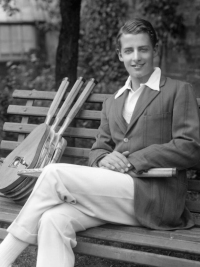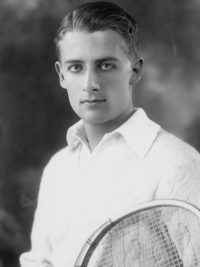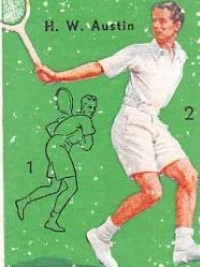Henry W. Austin
Full name: Henry William Austin
Nickname: Bunny
Nickname: Bunny
| Born |
Subscribe now
This information and data is not available because you are not our subscriber yet.
Please click here and get full access to the entire database! |
|---|---|
| Died | |
| Class of HOF | |
| Height | |
| Weight | |
| Plays | |
| Bio | A charismatic player who inspired good sportsmanship with his dignified conduct on and off the court, Austin was twice a singles finalist at Wimbledon, and once at the French Championships. He was also twice the second-ranked player in the world during the 1930s, and a Davis Cup stalwart who captured 36 of 48 singles matches for Great Britain. He was perhaps most remembered, however, for his attire, becoming the first male player to wear shorts during match play. He was a British tennis player from England. For 74 years he was the last Briton to reach the final of the gentlemen's singles at Wimbledon, until Andy Murray did so in 2012. He was also a finalist at the 1937 French Championships and a championship winner at Queen's Club. Along with Fred Perry, he was a vital part of the British team that won the Davis Cup in three consecutive years (1933–35). The son of stockjobber Wilfred Austin and his wife Kate, Austin was brought up in South Norwood, London. Austin concluded that the nickname "Bunny", bestowed on him by school friends, came from the Daily Mirror comic strip Pip, Squeak and Wilfred (Wilfred was a rabbit, or bunny). Encouraged by his father, who was determined that he become a sportsman, he joined Norhurst Tennis Club aged six. Austin was educated at Repton School, and studied history at Pembroke College, Cambridge. While still an undergraduate at Cambridge University, he reached the semi-finals of the men's doubles at Wimbledon in 1926. In 1931, A. Wallis Myers of The Daily Telegraph ranked Austin as the World No. 2. In his first Wimbledon men's singles final in 1932, he was beaten by Ellsworth Vines of the United States in three sets. In 1932 he decided that the traditional tennis attire, cricket flannels, weighed him down too much. He bought a pair of shorts to use at Forest Hills and subsequently became the first player to wear them at Wimbledon. Austin reached the quarter finals or better at Wimbledon 10 times. At Wimbledon 1932 Austin beat Frank Shields and Jiro Satoh before losing the final in straight sets to Ellsworth Vines. At the French championships in 1937, Austin beat Yvon Petra before losing to Henner Henkel in the final. At Wimbledon 1938 Austin beat Henkel but won just four games in the final against Don Budge, who was at the peak of his form and went on to win the Grand Slam. He would be the last British man to reach the final of a Grand Slam tournament until Andy Murray in 2012. At Wimbledon 1939 Austin was top seed, but lost early. It was his last appearance at Wimbledon. In the years 1933-36 he and Fred Perry helped to win the Davis Cup for Britain. Austin also pioneered the design of the modern tennis racquet by inventing the 'Streamline' – a racquet with a shaft that splits into three segments – allowing for aerodynamic movement. The design was manufactured by Hazells and at the time was mocked in the press for looking like a snow shoe. After Austin's retirement, the design was virtually forgotten until the reintroduction of the split shaft in the late 1960s. He married actress Phyllis Konstam in 1931, after meeting her in 1929 on a transatlantic liner while travelling for the US Open, and together they were one of the celebrity couples of the age. Austin played tennis with Charlie Chaplin, was a friend of Daphne du Maurier, Ronald Colman, and Harold Lloyd, and met both Queen Mary and President Franklin Delano Roosevelt. In 1933, concerned by increasing threats of a renewal of European, and indeed wider, war, Austin became involved in the Oxford Group, later Moral Re-Armament, speaking on public platforms and writing press articles. He and Fred Perry were the only players to raise their voice, in a letter to The Times, against the Nazi ban on Jews joining the German team for the Davis cup. According to Austin's friend Peter Ustinov, Austin was "disgracefully ostracised by the All-England Club because he was a conscientious objector". In fact, soon after British declaration of the Second World War, before the question whether he might register as an objector arose, he accepted an invitation from Frank Buchman, Oxford Group founder, for a speaking tour of the USA, and went, with the apparently overt approval of the British government. In 1943, with the extension of US conscription to Allied resident citizens, he was drafted into the US Army Air Force, but a diagnosis of Gilbert's Syndrome (periodic malfunction of the liver) precluded him from combat service, and he was discharged in 1945. [The syndrome explained his occasional and sudden fatigue on the court. When he returned to Britain in 1961, a voting member of the Membership Committee of the All-England Club who had been removed from the Cambridge tennis team during Austin's captaincy used Austin's alleged proselytism for the Oxford Group as an excuse for denying him reinstatement in the All-England Club after a lapse of dues payment. His membership of the club was restored in 1984, the year the obstructing member died. After a serious fall in 1995, Austin moved to a nursing home at Coulsdon, London. He died in 2000 on his 94th birthday. His grave is in the village churchyard of Stoke St Gregory in Somerset. A few months earlier he had joined other past Wimbledon champions and finalists on Wimbledon's Centre Court for a pre-millennium parade of champions. Austin was inducted into the International Tennis Hall of Fame at Newport, Rhode Island, in 1997. His sister Joan Austin was also a tennis player. |
| Misc | Subscribe now |
| Tournament | AO | RG | W | US | Win-Loss |
|---|---|---|---|---|---|
|
Subscribe now
This information and data is not available because you are not our subscriber yet.
Please click here and get full access to the entire database! |
|||||




